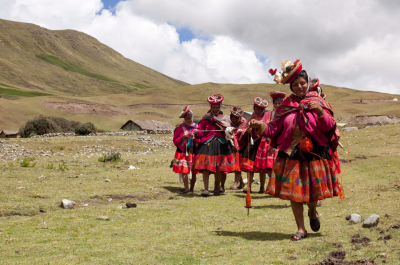1. Traditional designs are known as “pallay” in the Quechua language
Impress your friends when visiting Peru by referring to the intricately woven designs as “pallay” (pie-y-eye), the Quechua term. Then really steal the crowd with these 2 little known facts - 1. each decorative stripe is considered a pallay, as opposed to the combination of all the designs in the textile and 2. each pallay is created using only 2 or 3 colors of thread. That may be difficult to believe, thinking of how vibrant and varied the colors are, but take a closer look! The base color is usually lighter, such as undyed alpaca, with the others being brighter or darker to make the pattern itself pop! Want to learn more? Follow this link: http://threadsofperu.com/symbols-patterns/.

Photo by Lizz Giordano
2. Colors and designs differ from community to community
When it comes to weaving in the high Andes, not all communities weave the same! Meaning to say that even neighboring communities have developed their own respective symbolism through particular pallays and color combinations. As they learn entirely by observation (from the time they are infants in their mothers’ carrying shawls!) and years of practice, it is very challenging for Quechua weavers to produce designs or naturally dyed colors that are not known to their region. Throughout history and into the present day, this has contributed to communities actually being able to recognize each other only by the designs in their mantas (traditional carrying shawls) or colors of their ponchos.

Photo by Kelsey Quam
3. Textiles are as much infused with historical significance as daily inspirations
It is an incredible experience to look at an Andean textile and see iconography that depicts tales of Incan battles and colonial Spanish culture. But that is not to say that inspiration for these beautifully hand-woven textiles only comes from the past! Men and women infuse their work with their personal experiences and surroundings, whether they be animals found in their villages - from rabbits to wild Andean birds - or the glittering night’s sky. There is also cultural significance in weaving certain pieces, such as is evident in our MUNAY wedding runner (http://threadsofperu.com/shop/cream-wedding-runner/), whose “pallay” of interlocking humming birds signifies love and affection. In working to preserve this piece of cultural heritage, we are also supporting traditional artisans in being able to continue to share the stories of their ancestors as well as their own!

Photo by Dana Blair
4. The tradition of weaving in Peru is over 5,000 years old!
Life in the high Andes, despite the rapid growth of the tourism and mining industries in Peru, has changed very slowly over the centuries. In addition to that being evident in the style of dress and typical food (lots of potatoes!), weaving textiles on the backstrap loom has been practiced in almost exactly the same manner for close to 5,000 years! The ancient Paracas culture, on the coast of Peru, is renowned for their well-preserved, vibrant textiles, as well as the infamous Inca empire, that maintained weaving houses (awana wasi in Quechua) to produce some of the finest woven cloth known to history.

Photo by Lizz Giordano
5. Men and women will begin to teach their children to spin as early as 6 years old
Even upon observing the unconscious manner in which indigenous weavers work, it’s still quite surprising that they are spinning raw fiber and warping their first looms at a very young age! Many men and women today, including the majority of the artisans with whom we work, still highly value that their children learn to weave traditional textiles and pass that heritage along when they begin their own families. The son, Nilson, of our friend and colleague, Daniel Sonqo (http://threadsofperu.com/master-weavers/), has just turned 15 and is already producing very high quality scarves and bags for sale. Talk about a different kind of high school job!

Photo by Michael Marquand

